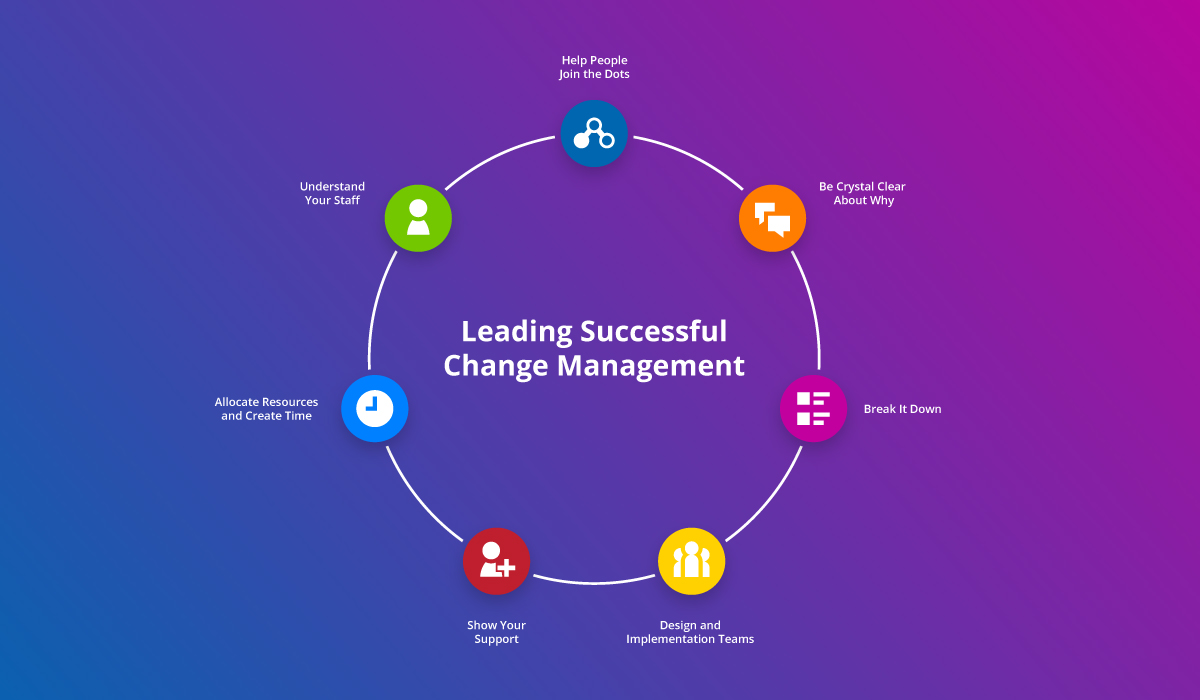In today’s world, change is constant and the education industry is not immune. Often we find that change is met with resistance, mainly due to a history of failed change initiatives and change fatigue.
As leaders, it’s important to go on a journey with our staff when implementing change, and managing change becomes an essential and important skill for us to master.
Here are some strategies that we have used in our schools to successfully manage, navigate, and implement change.
Help People Join the Dots
As leaders, it’s our job to help people see the bigger picture and understand how the change we’re proposing meets the schools current and future needs.
In our experience, we’ve found that by showing our staff some of the ways that the proposed change will make their lives better went a long way. Previously, we had a cumbersome way of taking attendance, so once we were able to highlight how implementing this new technology will make taking attendance much simpler, they were able to shift their mindset and get on board with the change.
Be Crystal Clear About Why
When proposing a change, it’s essential to be crystal clear about why you’re doing it, and that your staff know that it is not just change for the sake of change.
We’ve found that communicating what our long-term vision is, and how the change will impact both students and staff in the short term helped to alleviate anxiety, and give people a sense of purpose. This allowed them to see themselves as part of the change, instead of outside the change and being left behind.
Build Trust
The cultural element of change is often overlooked, and it is critical to successfully implementing change.
As leaders, if we say we are going to deliver ABC, and then deliver XYZ instead, we will erode away at the trust we have built with our team. If this is something that continues to happen, you will develop a culture, but it will be a culture of distrust. It is important to deliver on promises, and do what we say we’re going to do.
It is also important to recognise and honour work that has previously been done. If someone had previously done a bunch of work for a project that never got off the ground, instead of making them do it again for a slightly different version of the project, think about how you can leverage the existing work and assets.
Listen to the Edleaders podcast to hear more about the correlation between culture and leadership.
Break it Down
Big changes can be overwhelming, so it’s essential to break them down into a manageable road map. We have had success using and celebrating milestones.
By creating a plan that outlines what will happen in each term or semester, people can easily see the journey ahead. We have found this approach has helped people understand that change is a process and that they can take baby steps towards the bigger picture, it won’t all happen overnight. Early wins are important here and help create momentum for successful change.
Allocate Resources and Create Time
Correctly resourcing a project with appropriate human capital and time for staff to upskill will result in better outcomes.
What does not work is trying to squeeze a big change management project into someone’s existing role without adding additional resources.
We have found that allocating a project manager with specialised skills who can own the project, and ensuring that the project manager has the resources that they need to be able to do their job (including project sponsors, and the support of the schools executive team and Board) is critical to the overall success of the project.
Create Dedicated Design Teams
It is useful to have design teams that represent the diversity and differing perspectives of the key stakeholders within your school.
In a recent experience of introducing new technology into our school, we found that setting up a small design team of 6-8 people with 3 different types of people within the school worked really well to help minimise the disconnection.
- The ‘haters’ – the ones that will be strongly opposed to the change will challenge your way of thinking, and will make you work harder in finding the best way forward
- The champions of the change – the people who are already using the tech and love it
- The neutrals – those that could be swayed either way and need to be convinced that this is a good (or bad) idea
Show Your Support
Change can be scary, so it’s crucial to show people that you’re there to support them. Strategies that have worked for us have been setting up help desks, creating resources with additional information (such as videos and slide decks), and just letting people know that we’re always here to help and support them through the transition.
May your next change project be one of success and great impact. If you want to listen to the full podcast access it here.

Luke Callier
Director of Discovery
St Hilda's Anglican School for Girls

Mat Irving
Deputy Head (Academics & Strategy)
Wesley College WA







